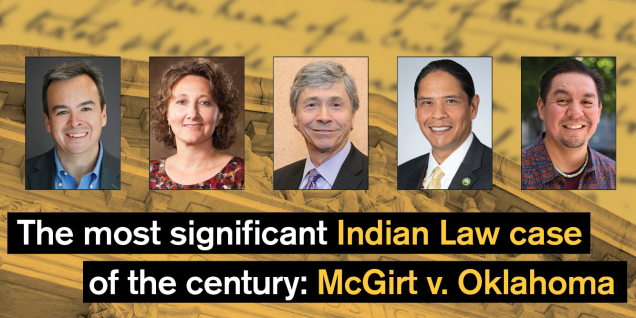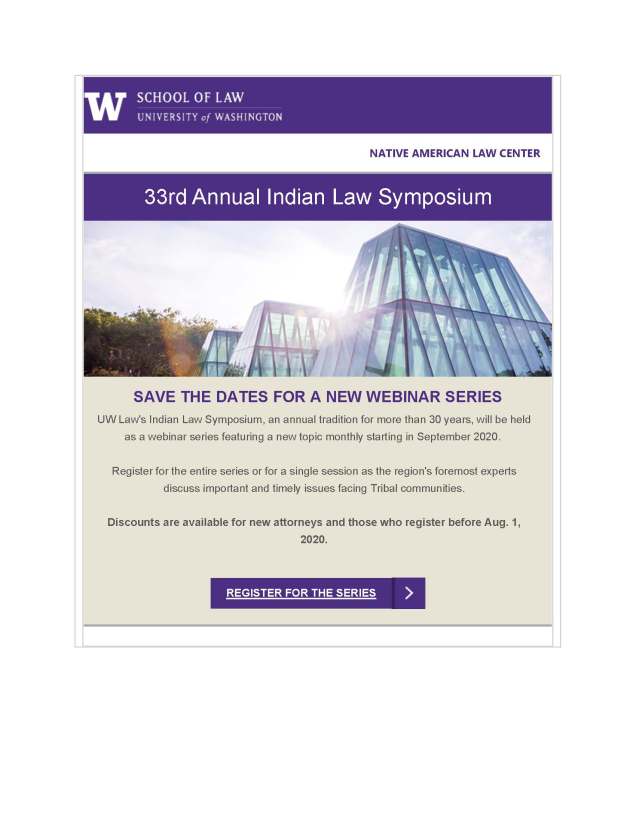Here.
WSJ Review of Stephen Graham Jones, “The Only Good Indians”
Here.
Fourth Circuit Denies Enforcement of Tribal Payday Lending Arbitration and Governing Law Provisions in Two Decisions
Here are the materials in Gibbs v. Haynes Investments LLC:
American Association for Justice Amicus Brief
Here are the materials in Gibbs v. Sequoia Capital Operations LLC:
Oklahoma SCT Holds Gov. Stitt Did Not Possess Authority to Enter into Gaming Compacts with Comanche Nation & Ote-Missouri Tribe
Here is the opinion in Treat v. Stitt:
Michael Daugherty: “Tribal courts should abolish cash bail”
From High Country News, here.
Jabot Podcast: “The Native American Critique Of New Law School Study”
Here, featuring two of my former students (!), not that it’s about me.
Links embedded in the article here:
Additional Reading:
– Native women law students excluded from so-called “Women of Color in Law Schools” study
– Native American Attorney Study
Environmental Law Review Symposium on 50th Anny of Sohappy/Belloni Decision
Here:
Charles Wilkinson
Judge Belloni’s decision in United States v. Oregon, handed down a half-century ago, has been given short shrift by lawyers, historians, and other commentators on the modern revival of Indian treaty fishing rights in the Pacific Northwest. The overwhelming amount of attention has been given to Judge Boldt’s subsequent decision in United States v. Washington and the Passenger Vessel ruling by the Supreme Court affirming Judge Boldt. I’m one who has been guilty of that.
We now can see that United States v. Oregon was the breakthrough. In those early days, Judge Belloni showed deep understanding of the two key bodies of law and policy—classic Indian Law dating back to John Marshall and the new ideas just beginning to remake public wildlife law and policy. We can fairly doubt that Judge Boldt and the Supreme Court would have ruled as they did if Judge Belloni had not written his profoundly insightful and brave opinion. Further, the Belloni decision reached beyond Indian treaty rights per se, energizing the emerging broad and fundamental movement for Indian tribal sovereignty that has revitalized Indian Country. Even more broadly, the decision led the way in the long and difficult chain of events that finally allowed the beauty of the rule of law to rise above the contentious and seemingly insolvable disputes over Indian fishing rights in the Pacific Northwest.
Michael C. Blumm. & Cari Baermann
Fifty years ago, Judge Robert Belloni handed down a historic treaty fishing rights case in Sohappy v. Smith, later consolidated into United States v. Oregon, which remains among the longest running federal district court cases in history. Judge Belloni ruled that the state violated Columbia River tribes’ treaty rights by failing to ensure “a fair share” to tribal harvesters and called upon the state to give separate consideration to the tribal fishery and make it a management priority co-equal with its goals for non-treaty commercial and recreational fisheries. This result was premised on Belloni’s recognition of the inherent biases in state regulation, despite a lack of facial discrimination.
The decision was remarkable because only a year before, in Puyallup Tribe v. Department of Game, the U.S. Supreme Court seemed to accord considerable deference to state regulation of tribal harvests (which it would soon clarify and circumscribe). Instead of deference, the Belloni decision reinstated burdens on state regulation that the Supreme Court had imposed a quarter-century earlier, in Tulee v. Washington, but seemed to ignore in its Puyallup decision. The directive for separate management was prescient because otherwise, tribal harvests would remain overwhelmed by more numerous and politically powerful commercial and recreational fishers.
Judge Belloni eventually grew tired of resolving numerous conflicts over state regulation of the tribal fishery, calling for the establishment of a comprehensive plan, agreed to by both the state and the tribes, to manage Columbia Basin fish harvests. Eventually, such a plan would be negotiated, implemented, and amended over the years. Today, the Columbia River Comprehensive Management Plan is still in effect a half-century after the Belloni decision, although the district court’s oversight role is now somewhat precariously perched due to statements by Belloni’s latest successor. Nonetheless, the plan remains the longest standing example of tribal–state co-management in history and a model for other co-management efforts. The Belloni decision was the first judicial recognition of the importance of the tribal sovereignty in regulating reserved rights resources. This Article examines the origins, effects, and legacy of the Belloni decision over the last half-century.
Beyond the Belloni Decision: Sohappy v. Smith and the Modern Era of Tribal Treaty Rights
Monte Mills
Indian tribes and their members are leading a revived political, legal, and social movement to protect the nation’s natural resources. In doing so, tribes and their allies employ many effective strategies but core to the movement are the historic promises made to tribes by the United States through treaties. Tribes are asserting treaty-protected rights, which the United States Constitution upholds as the supreme law of the land, to defend the resources on which they and their ancestors have relied for generations. Those claims have resulted in significant legal victories, igniting a broader movement in favor of tribal sovereignty and securing a prominent and perpetual tribal presence in the movement and on the ground.
Given the strength of this modern movement and the centrality of treaty rights to its success, it is hard to believe that, just two generations ago, those rights faced seemingly existential threats. Notwithstanding bedrock Supreme Court precedent from the first half of the 1900s recognizing the supremacy of Indian treaties, tribal members exercising the rights those treaties guaranteed were under attack in the Pacific Northwest and the Great Lakes, with armies of state wildlife rangers and law enforcement arresting tribal members for not following state laws and regulations. Then, in 1968, the Supreme Court cut against its earlier solicitude for tribal treaty rights by opening the door for broad state power to establish laws, rules, and regulations that could govern tribal members engaged in treaty-reserved activities. Facing escalating harassment from state authorities, the Court’s endorsement of state priorities seemed to leave little room for the meaningful exercise of treaty rights as the tribes and tribal members themselves saw fit.
But, with his 1969 decision in Sohappy v. Smith, Judge Robert Belloni began to reverse the course of that time and, in doing so, opened the modern era of tribal sovereignty over natural resources. Judge Belloni’s approach to reaching that momentous decision recognized the permanence and supremacy of tribal treaties while also accounting for the ongoing exercise of state sovereignty. Rather than approach the balance of those two interests as a zero-sum proposition, however, Judge Belloni sought and provided practical guidance pursuant to which states and tribes could work together to ensure their continued coexistence. While that coexistence would demand higher burdens and more limitations on the state’s exercise of authority, Judge Belloni also had the foresight to provide a judicial forum for resolving conflicts over those burdens and limitations and urged the parties to reach cooperative agreements beyond the courtroom doors. Judge Belloni’s approach and the Sohappy decision laid the foundation for state and federal courts struggling to balance state authority and tribal treaty rights. This Article traces the legacy of the Sohappy decision across litigation in the Great Lakes region, where members of the Chippewa Tribes fought to continue their time-honored and treaty-reserved practices, various states sought to regulate those activities, and judges relied on Judge Belloni’s wisdom and insight to reach sustainable solutions.
Sammy Matsaw, Dylan Hedden-Nicely, & Barbara Cosens
Language is a reflection of a thought world. A worldview that has been shaped by place to describe one’s identity in space and time does not equate to species relatedness as a default to know one another. In the legal system of the United States, there is acknowledgement of treaties in colonized lands that there are rights granted from the tribes and not to them, and those rights are land-based. Yet, the Indigenous voice is dead before arrival, before it enters the room of science, justice, academe, or otherwise. The exclusion of Indigenous peoples at the table of knowledge and from the power to make decisions within their homelands has proven a detriment to the land, waterways, flora and fauna, and human beings. Nowhere would tribal peoples have agreed to our own destruction, it is and has been a forced hand. This Article explores the changing interpretation of the U.S. Supreme Court canon to construe treaties with Native American tribes as the tribe would have understood them, and why mere translation of Native language to English fails to capture a Native understanding. Through the juxtaposition of western legal analysis and the powerful voice of a Native scientist, this Article illustrates how difficult and yet how necessary it will be to bridge that divide if this powerful western nation is to fulfill its sacred promises to Native people. As a contribution to the Issue on the fiftieth anniversary of United States v. Oregon, this Article looks to the future of federal jurisprudence on the interpretation of treaties with American Indians and envisions one in which reconciliation through an understanding of different worldviews is possible.
How Much Evidence Should We Need to Protect Cultural Sites and Treaty Rights?
Jeffrey B. Litwak
Too often, the administrative and judicial systems require tribes to reveal too much about their cultural site and treaty rights before agencies and courts are willing or “able” to protect them. Tribes must make a difficult decision whether to reveal information about their cultural site and treaty rights practices, which, when made public, leads to damage, vandalism, and personal safety concerns. To prevent these effects, agencies and courts can, and should, consider these concerns in determining how much detail is needed to constitute “substantial evidence.” This Article gives examples from the practice of the Columbia River Gorge Commission, a regional land use planning agency created by an interstate compact between Oregon and Washington, which, by its compact, must engage with the four Columbia River Treaty Tribes and protect cultural resources and treaty rights.
ASU Law Program on McGirt
Here:
The most significant Indian Law case of the century: McGirt v. Oklahoma
Thursday, July 23, 2020
1 p.m. PT
The Indian Legal Program at the Sandra Day O’Connor College of Law at Arizona State University is pleased to have the following distinguished panelist discuss the recent McGirt Decision.
- Professor Larry Roberts (Oneida) – Moderator, Executive Director of the Indian Gaming and Tribal Self-Governance Program and Professor of Practice at the Sandra Day O’Connor College of Law
- Stacy Leeds (Cherokee) – Vice Chancellor for Economic Development, Dean Emeritus and Professor of Law at the University of Arkansas
- Professor Robert Miller (Eastern Shawnee) – Faculty Director, Rosette LLP American Indian Economic Development Program and Pedrick Distinguished Research Scholar at the Sandra Day O’Connor College of Law
- Jonodev Chaudhuri (Muscogee Creek Nation) – Ambassador, Muscogee Creek Nation, Partner, Quarles & Brady
- Derrick Beetso (’10) (Navajo) – General Counsel, National Congress of American Indian
This webinar is free and open to the public. We wish to acknowledge our co-sponsor NABA-AZ. The State Bar of Arizona does not approve CLE activities, however, this activity may qualify for up to 1.5 credit hours.

Univ. of Washington 33rd Annual Indian Law Symposium – Save the Date
N.Y. Supreme Court Dismisses Cayuga Nation Defamation Suit re: “Billions” T.V. Show
Here is the order in Cayuga Nation v. Showtime Networks Inc. (N.Y. Sup. Ct.):
Briefs:
Here is the Native America Calling show where Fletcher discussed the suit when it was filed.
We posted the complaint here.

You must be logged in to post a comment.